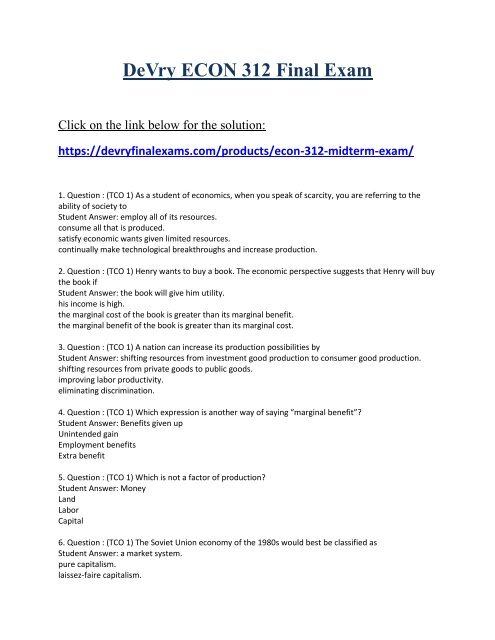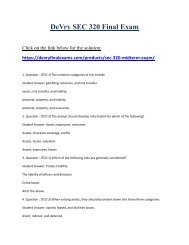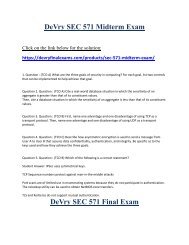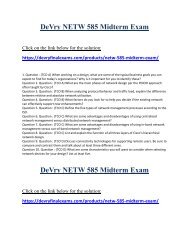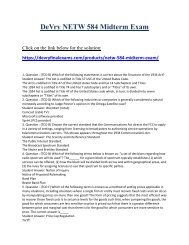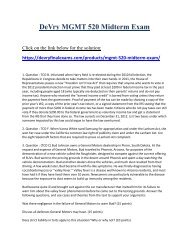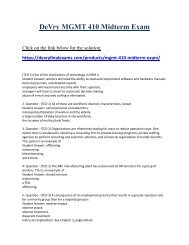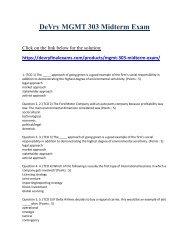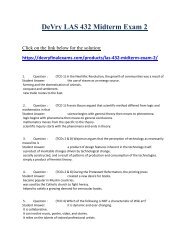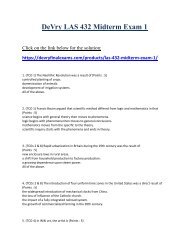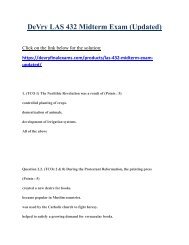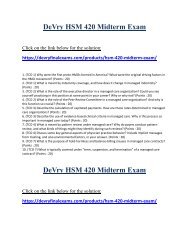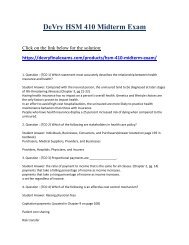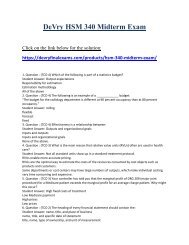ECON 312 Midterm Exam
You also want an ePaper? Increase the reach of your titles
YUMPU automatically turns print PDFs into web optimized ePapers that Google loves.
DeVry <strong>ECON</strong> <strong>312</strong> Final <strong>Exam</strong><br />
Click on the link below for the solution:<br />
https://devryfinalexams.com/products/econ-<strong>312</strong>-midterm-exam/<br />
1. Question : (TCO 1) As a student of economics, when you speak of scarcity, you are referring to the<br />
ability of society to<br />
Student Answer: employ all of its resources.<br />
consume all that is produced.<br />
satisfy economic wants given limited resources.<br />
continually make technological breakthroughs and increase production.<br />
2. Question : (TCO 1) Henry wants to buy a book. The economic perspective suggests that Henry will buy<br />
the book if<br />
Student Answer: the book will give him utility.<br />
his income is high.<br />
the marginal cost of the book is greater than its marginal benefit.<br />
the marginal benefit of the book is greater than its marginal cost.<br />
3. Question : (TCO 1) A nation can increase its production possibilities by<br />
Student Answer: shifting resources from investment good production to consumer good production.<br />
shifting resources from private goods to public goods.<br />
improving labor productivity.<br />
eliminating discrimination.<br />
4. Question : (TCO 1) Which expression is another way of saying “marginal benefit”?<br />
Student Answer: Benefits given up<br />
Unintended gain<br />
Employment benefits<br />
Extra benefit<br />
5. Question : (TCO 1) Which is not a factor of production?<br />
Student Answer: Money<br />
Land<br />
Labor<br />
Capital<br />
6. Question : (TCO 1) The Soviet Union economy of the 1980s would best be classified as<br />
Student Answer: a market system.<br />
pure capitalism.<br />
laissez-faire capitalism.
a command system.<br />
7. Question : (TCO 1) Markets in which firms sell their output of goods and services are called<br />
Student Answer: resource markets.<br />
product markets.<br />
command markets.<br />
mixed markets.<br />
8. Question : (TCO 1) Consumers express self-interest when they<br />
Student Answer: seek the lowest price for a product.<br />
reduce business losses.<br />
collect economic profits.<br />
search for jobs with the highest wages.<br />
9. Question : (TCO 1) Which is not one of the five fundamental questions that an economy must deal<br />
with?<br />
Student Answer: How will the goods and services be produced?<br />
Why should the goods and services be produced?<br />
Who is to receive the goods and services produced in the economy?<br />
In what ways will progress be promoted?<br />
10. Question : (TCO 1) The major “success indicator” for business managers in command economies like<br />
the Soviet Union and China in the past was<br />
Student Answer: the quantity of output.<br />
product quality.<br />
the amount of profits.<br />
worker morale.<br />
11. Question : (TCO 2) An increase in demand means that<br />
Student Answer: given supply, the price of the product will decline.<br />
the demand curve has shifted to the right.<br />
price has declined and consumers therefore want to purchase more of the product.<br />
the demand curve has shifted to the left.<br />
12. Question : (TCO 2) A surplus of a product will arise when price is<br />
Student Answer: above equilibrium with the result that quantity demanded exceeds quantity supplied.<br />
above equilibrium with the result that quantity supplied exceeds quantity demanded.<br />
below equilibrium with the result that quantity demanded exceeds quantity supplied.<br />
below equilibrium with the result that quantity supplied exceeds quantity demanded.<br />
13. Question : (TCO 2) If an effective price ceiling is placed on hamburgers then<br />
Student Answer: the quantity demanded will exceed the quantity supplied.<br />
a black market for hamburger may evolve.<br />
consumers may want government to ration hamburger.<br />
all of these are likely outcomes.<br />
14. Question : (TCO 2) Which would cause an increase in quantity supplied of Product A?<br />
Student Answer: An improvement in technology affecting the production of A
An increase in the price of Product B, an input in the production of A<br />
A decrease in the taxes paid by producers of A<br />
An increase in the price of A<br />
15. Question : (TCO 2) Two months ago, the Marbury Shirt company sold 200 shirts at $30 per shirt. Last<br />
month, the company raised its price to $35 per shirt and sold 300 shirts. Evidently the company<br />
experienced a(n)<br />
Student Answer: decrease in demand.<br />
increase in demand.<br />
decrease in supply.<br />
increase in supply.<br />
16. Question : (TCO 2) If the price elasticity of demand for a product is equal to 0.5, then a 10 percent<br />
decrease in price will increase quantity demanded by<br />
Student Answer: 20 percent.<br />
0.5 percent.<br />
5 percent.<br />
0.05 percent.<br />
17. Question : (TCO 2) When the price of movie tickets in a certain town was reduced, the movietheaters’<br />
revenues did not change. This suggests that the demand for movie tickets in that town has<br />
a price-elasticity coefficient of<br />
Student Answer: 1.0.<br />
greater than 1.<br />
0.5.<br />
zero.<br />
18. Question : (TCO 2) The demand for Cheerios cereal is more price-elastic than the demand for cereals<br />
as a whole. This is best explained by the fact that<br />
Student Answer: Cheerios are a luxury.<br />
cereals are a necessity.<br />
there are more substitutes for Cheerios than for cereals as a whole.<br />
consumption of cereals as a whole is greater than consumption of Cheerios.<br />
19. Question : (TCO 2) A state government wants to increase the taxes on cigarettes to increase tax<br />
revenue. This tax would only be effective in raising new tax revenues if the price elasticity of demand is<br />
Student Answer: unity.<br />
elastic.<br />
inelastic.<br />
perfectly elastic.<br />
20. Question : (TCO 2) Movie theaters charge lower prices to see a movie in the afternoon than in the<br />
evening because there is an<br />
Student Answer: inelastic supply of movies in the evening.<br />
elastic demand to see movies in the evening.<br />
elastic demand to see movies in the afternoon.<br />
inelastic demand to see movies in the afternoon.
21. Question : (TCO 3) Which would be an implicit cost for a firm? The cost<br />
Student Answer: of worker wages and salaries for the firm.<br />
paid for leasing a building for the firm.<br />
paid for production supplies for the firm.<br />
of wages foregone by the owner of the firm.<br />
22. Question : (TCO 3) Suppose that a firm produces 200,000 units a year and sells them all for $10 each.<br />
The explicit costs of production are $1,500,000 and the implicit costs of production are $300,000. The<br />
firm earns an accounting profit of<br />
Student Answer: $500,000 and an economic profit of $200,000.<br />
$400,000 and an economic profit of $200,000.<br />
$300,000 and an economic profit of $400,000.<br />
$200,000 and an economic profit of $500,000.<br />
23. Question : (TCO 3) The long run is a period of time, or a time frame, in which<br />
Student Answer: all resources are fixed.<br />
the level of output is fixed.<br />
the amount of all resources can be varied.<br />
the capacity of the production plant is fixed.<br />
24. Question : (TCO 3) The law of diminishing returns only applies in cases where<br />
Student Answer: there is increasing scarcity of factors of production.<br />
the price of extra units of a factor is increasing.<br />
there is at least one fixed factor of production.<br />
capital is a variable input.<br />
25. Question : (TCO 3) The phrase “don’t cry over spilt milk” could be rephrased in economic terms by<br />
saying<br />
Student Answer: “sunk costs are irrelevant to a decision.”<br />
“real resources have opportunity costs.”<br />
“there are economies and diseconomies of scale.”<br />
“the law of diminishing returns applies to everything.”<br />
26. Question : (TCO 3) A fast-food company spends millions of dollars to develop and promote a new<br />
hamburger on its menu only to find that consumers won’t buy it because they don’t like the taste. From<br />
an economic perspective, the company should<br />
Student Answer: keep the hamburger on the menu because they’ve spent so much money and time<br />
developing and promoting the product.<br />
spend more money to develop a more efficient way to cook the hamburger so it cooks in a shorter time.<br />
pull the hamburger off the menu and treat the development and promotion expenditures as a sunk cost.<br />
keep trying to sell the hamburger so that people who developed and promote it have a job with the<br />
company.<br />
1. Question : (TCO 3) Mutual interdependence would tend to limit control over price in which market<br />
model?<br />
Student Answer: Monopolistic competition<br />
Pure competition<br />
Pure monopoly
Oligopoly<br />
2. Question : (TCO 3) Local electric or gas utility companies mostly operate in which market model?<br />
Student Answer: Monopolistic competition<br />
Pure competition<br />
Pure monopoly<br />
Oligopoly<br />
3. Question : (TCO 3) The steel and automobile industries would be examples of which market model?<br />
Student Answer: Monopolistic competition<br />
Pure competition<br />
Pure monopoly<br />
Oligopoly<br />
4. Question : (TCO 3) In pure competition, the demand for the product of a single firm is perfectly<br />
Student Answer: elastic because the firm produces a unique product.<br />
inelastic because the firm produces a unique product.<br />
elastic because many other firms produce the same product.<br />
inelastic because many other firms produce the same product.<br />
5. Question : (TCO 3) T-Shirt Enterprises is selling in a purely competitive market. It is producing 3,000<br />
units, selling them for $2 each. At this level of output, the average total cost is $2.50 and t<br />
he average variable cost is $2.20. Based on these data, the firm should<br />
Student Answer: shut down in the short run.<br />
decrease output to 2,500 units.<br />
ontinue to produce 3,000 units.<br />
increase output to 3,500 units.<br />
6. Question : (TCO 3) A firm should always continue to operate at a loss in the short run if<br />
Student Answer: the firm will show a profit.<br />
the owner enjoys helping her customers.<br />
it can cover its variable costs and some of its fixed costs.<br />
the firm cannot produce any other products more profitably.<br />
7. Question : (TCO 3) The short-run supply curve for a competitive firm is the<br />
Student Answer: entire MC curve.<br />
segment of the MC curve lying below the AVC curve.<br />
segment of the MC curve lying above the AVC curve.<br />
segment of the AVC curve lying to the right of the MC curve.<br />
8. Question : (TCO 3) The classic example of a private, unregulated monopoly is<br />
Student Answer: Xerox.<br />
De Beers.<br />
General Motors.<br />
General Electric.<br />
9. Question : (TCO 3) Barriers to entry<br />
Student Answer: usually result in pure competition.
can result from government regulation.<br />
exist in economic theory but not in the real world.<br />
are typically the result of wrongdoing on the part of a firm.<br />
10. Question : (TCO 3) One feature of pure monopoly is that the demand curve<br />
Student Answer: is vertical.<br />
is horizontal.<br />
slopes upward.<br />
slopes downward.<br />
11. Question : (TCO 3) Which would definitely not be an example of price discrimination?<br />
Student Answer: A theater charges children less than adults for a movie.<br />
Universities charge higher tuition for out-of-state residents.<br />
A doctor charges for services according to the income of patients.<br />
An electric power company charges less for electricity used during off-peak hours when production costs<br />
are lower.<br />
12. Question : (TCO 3) Which of the following is a characteristic of monopolistic competition?<br />
Student Answer: Standardized product<br />
Relatively small number of firms<br />
Absence of nonprice competition<br />
Relatively easy entry<br />
13. Question : (TCO 3) Assume that in a monopolistically competitive industry, firms are earning<br />
economic profit. This situation will<br />
Student Answer: reduce the excess capacity in the industry as firms expand production.<br />
attract other firms to enter the industry, causing the firm’s profits to shrink.<br />
cause firms to standardize their product to limit the degree of competition.<br />
make the industry allocatively efficient as each firm seeks to maintain its profits.<br />
14. Question : (TCO 3) In an oligopolistic market there are<br />
Student Answer: many buyers.<br />
few buyers.<br />
few sellers.<br />
many sellers.<br />
15. Question : (TCO 3) A high concentration ratio indicates that<br />
Student Answer: the industry is highly profitable.<br />
the industry is highly competitive.<br />
many firms produce most of the output in an industry.<br />
few firms produce most of the output in an industry.<br />
16. Question : (TCO 3) In which set of market models are there the most significant barriers to entry?<br />
Student Answer: Monopolistic competition and pure competition<br />
Monopolistic competition and pure monopoly<br />
Oligopoly and monopolistic competition<br />
Oligopoly and pure monopoly
17. Question : (TCO 1) The four factors of production are<br />
Student Answer: land, labor, capital, and money.<br />
land, labor, capital, and entrepreneurial ability.<br />
labor, capital, technology, and entrepreneurial ability.<br />
labor, capital, entrepreneurial ability, and money.<br />
18. Question : (TCO 1) Refer to the diagram below which is based on the Circular Flow Model in Chapter<br />
2. Arrows (1) and (2) represent<br />
Graph Description<br />
Student Answer: goods and resources, respectively.<br />
money incomes and output, respectively.<br />
output and money incomes, respectively.<br />
resources and goods, respectively.<br />
19. Question : (TCO 2) Refer to the diagram. A decrease in quantity demanded is depicted by a<br />
Graph Description<br />
Student Answer: move from Point x to Point y.<br />
shift from D1 to D2.<br />
shift from D2 to D1.<br />
move from Point y to Point x.<br />
20. Question : (TCO 2) Refer to the information and assume the stadium capacity is 5,000. If the<br />
Mudhens’ management charges $7 per ticket<br />
Price per Ticket Quantity Demanded<br />
$13 1,000<br />
11 2,000<br />
9 3,000<br />
7 4,000<br />
5 5,000<br />
3 6,000<br />
Student Answer: some fans who want to see the game will find that tickets are not available.<br />
21. Question : (TCO 2) Which of the following goods (with their respective income-elasticity coefficients<br />
in parentheses) will most likely suffer a decline in demand during a recession?<br />
Student Answer: Dinner at a nice restaurant (+1.8)<br />
Chicken purchased at the grocery store for preparation at home (+0.25)<br />
Facial tissue (+0.6)<br />
Plasma-screen and LCD TVs (+4.2)<br />
22. Question : (TCO 3) In the figure, Curves 1, 2, 3, and 4 represent the<br />
Graph Description<br />
Student Answer: ATC, MC, AFC, and AVC curves, respectively.<br />
MC, AFC, AVC, and ATC curves, respectively.<br />
MC, ATC, AVC, and AFC curves, respectively.<br />
ATC, AVC, AFC, and MC curves, respectively.<br />
23. Question : (TCO 1) Refer to the diagram. If society is producing nine units of bicycles and four units<br />
of computers and it now decides to increase computer output to six, the cost
Graph Description<br />
Student Answer: will be four units of bicycles.<br />
will be two units of bicycles.<br />
will be zero because unemployed resources are available.<br />
of doing so cannot be determined from the information given.<br />
24. Question : (TCO 3) Assume that the owners of the only gambling casino in Wisconsin spend large<br />
sums of money lobbying state government officials to protect their gambling monopoly. Economists<br />
refer to these expenditures as<br />
Student Answer: rent-seeking.<br />
price discrimination.<br />
X-efficiency.<br />
network effects.<br />
25. Question : (TCO 3) a.) A pure monopolist determines that at the current level of output the marginal<br />
cost of production is $2, average variable costs are $2.75, and average total costs are $2.95. The<br />
marginal revenue is $2.75. What would you recommend that the monopolist do to maximize profits? b.)<br />
Why might a business owner keep their business open but let it deteriorate, rather than shut it down?<br />
Will this profitability last?<br />
26. Question : (TCO 2) What effect should each of the following have on the demand for gasoline in a<br />
competitive market? State what happens to demand. Explain your reasoning in each case and relate it to<br />
a demand determinant.<br />
(a) an increase in the number of cars<br />
(b) the economy moves into a recession<br />
(c) an increase in the price of car insurance, taxes, maintenance<br />
(d) consumer expectations of substantial price increases in gasoline<br />
DeVry <strong>ECON</strong> <strong>312</strong> Final <strong>Exam</strong><br />
Click on the link below for the solution:<br />
https://devryfinalexams.com/products/econ-<strong>312</strong>-midterm-exam/


